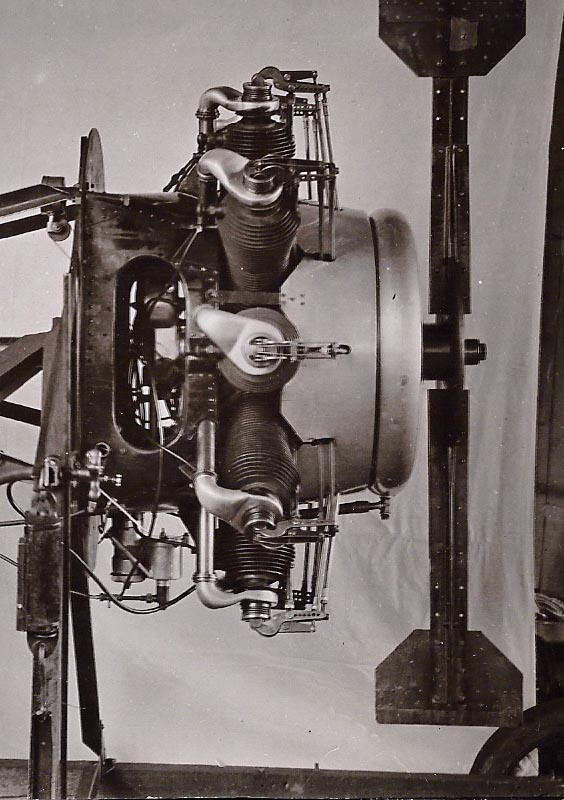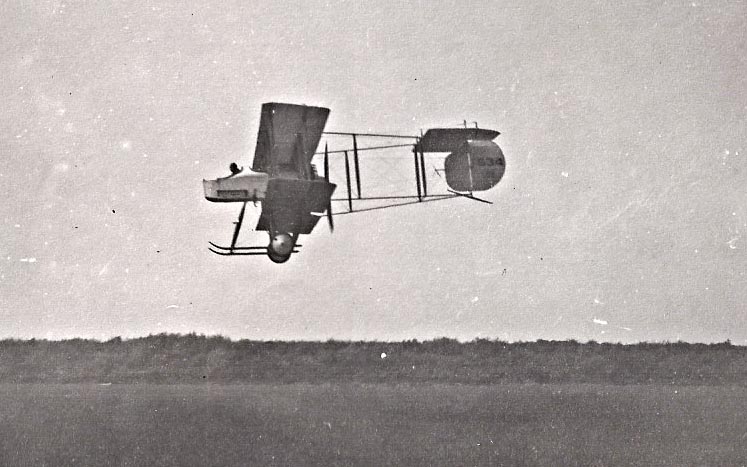|
An
American engine for the Vickers Gunbus in 1915
At
the outset of World War 1 the only aircraft designed for fighting in
the air was the Vickers Gunbus (later FB5). Initial orders for
the aircraft had come from the Navy but much of the production was
handed over (transferred) to the Army for the RFC.
In
the search for improved performance an engine designed by American
aviation pioneer and engine designer Mr John W Smith, the
Smith Static Motor, was trialled for the Vickers aircraft. Mr
Smith moved to England in 1915 and set up the British Static Motor Company
in Birmingham in partnership with Mr Charles Schofield. He
brought with him from Chicago an experienced engine mechanic Mr
Ralph Watson.
 © J Soderberg
© J Soderberg
Smith
Static Motor (on test stand)
During
1915 the engine was demonstrated to the Admiralty and the War Office
and was installed that summer on two Vickers FB5 aircraft (serial
no.s 1534 & 1535) for the Admiralty, the first of which was
delivered to RNAS Eastchurch (Isle of Sheppey) on 7 August 1915. The
Smith engine was relatively light and claimed to deliver 140 hp.
Watson
wrote to his wife on 8 August 1915 the day after No.1534s delivery:
"Just
arrived in Birmingham from London, it takes a little over 2 hours to
make the trip. I will be here for about a week I think unless they
have trouble with the motor down at the flying field. I was out to
the field [Joyce Green, Vickers test flight] yesterday
and saw them off for the other flying field belonging to the Navy [RNAS
Eastchurch]. And they want to play with it themselves for a
few days and make a few more tests. I was up the other day Friday it
was [30 July] with Mr. Barnwell the pilot [Vickers Chief
test pilot Harold Barnwell], he is one of the very best
there is over here so I am told and he knows how to fly all right. We
were only up at 1200 to 1500 feet, took a trip over a little Suburb
of London out there, and up and down over the Thames river and I felt
much safer in it than in an auto doing 60 mile per. hr. and we were
going better than 80 M.P.H."
 ©
J Soderberg ©
J Soderberg
Vickers
FB5 aircraft 1534
Clearly
more work was required to get the engine right. JW Smith wrote
to Watson (probably at RNAS Eastchurch) on 7 Dec 1915:
"I
sent along a valve unit, which consists of valve cage, exhaust and
intake valve so you could take out one of the old valves and put in
the new one.
The
old valves that are in the motor come from the States, and I thought
it would be well to keep one of these valves to show to anyone when I
wished to convince that after the motor had made 200 hours run the
valve was practically as good as new.
The
new Carburettor works perfectly on both high and low.
The
new sight feed [clear pipe for viewing the flow] works nicely
for any amount of oil that I want to use it on, and you had better
put in this new sight feed, and let it run a good bifuel stream to
the extent of 1 1/4 gal. to 1 1/2 gal. per hour which means a pretty
thick stream as the oil is heavy and moves slow.
I
gave the motor an hours run to-day to limber it up, and ground the
valves. If it has the punch to-morrow I will call up the Officials
for a test."
The
then RFC HQ Chief of Staff Lt Col. Brooke-Popham mentioned
the engine in a January 1916 report of his visit to Home
Establishment as follows:
The
Smith Radial engine was tested on Tuesday [18 Jan 1916]. It
ran for an hour giving 140 hp. and then broke a valve rocker. Its
weight is only 180 lbs. and if it can be got right it would seem that
it would be a very useful engine.
The
same report notes however the imminent arrival of a squadron of
FE2bs with 240 hp Rolls-Royce engines, another pusher aircraft that
effectively took over from the Vickers FB5 and 9, and saw out the war
as a night bomber.
Watson
writing to a friend at the Standard Steel Car Company in the US in
March 1916 commented on engines:
If
you are getting into this game you will find that it must be a motor
of the radial type and no doubt air cooled as that eliminates more
weight than anything else and pounds per HP will always be the
determining factor in aeroplane work. Besides the radial type lends
itself to plane construction on mounting. It takes one man about 4
days to dismount a Sunbeam motor from a fuselage. I have taken one of
Smith’s motors (off) in 20 minutes.
Flt
Cdr? W A Bristow writing to J W Smith in October 1916 from
the Admiralty Air Department was enthusiastic about the engine’s performance:
Working
out your figures after the test today I find the engine gave 131.3
BHP at 1,275 and the petrol consumption was .67 pts per BHP hour.
This
seems to be very good and the engine certainly ran better than ever.
It will be as well I think to lock the carburettor in the position we
ran it in today as I should like it to go into the air just as it was.
With
regard to request for suggestions as to improvements I am afraid it
is difficult to suggest anything really worth talking about. The
position of the carburettor might be changed &ldots;
But
as to the design and make of the engine there is nothing I can
suggest as an improvement. As you know I have flown with the engine
about a thousand miles and I certainly feel safer with it than almost
any other engine I have been up with.
What
I like about it is the ease of control and absence of vibration over
a wide range of speed and considering we have had to come down once
only and that not through any particular fault in the engine. It
speaks pretty well for it. Would it be possible to make a large
engine say 200/220 HP. You might think it over and let Commander
Briggs know.

©
J Soderberg
Smith’s
workshop in Birmingham
J
W Smith sold his share of the business (UK patent rights) to Mr
Heenan of Heenan & Froude Ltd in early 1916 but stayed on
under contract in UK to help the business at the Admiralty’s
request. The Smith motor production was moved to Heenan & Froude
Ltd at Worcester (see www.miac.org.uk/heenan.htm
) in April 1916 and the manufacturing suffered a number quality
problems leading eventually to the engine’s rejection by the Air
Board. The company had an initial order for 250 engines.
There
had been plans to fit a 140 HP Smith Static Motor in a prototype
seaplane PV4 designed by the Admiralty’s Port Victoria
Marine Experimental Aircraft Depot in 1916. The engine was not
delivered so a Clerget was tried in June 1917 but this proved too
long in body (compared to the Smith) to rig the machine for
longitudinal control across the speed range. A prototype for another
Admiralty designed float plane the AD Naviplane No. 9095 was
built in 1916 by Supermarine initially with a 150 HP Smith Static,
but this proved underpowered and the engine was replaced by a Bentley
Rotary 1 in 1917 which also failed to deliver the required
performance. The design was abandoned. The Blackburn TB twin
engine seaplane had been another possible user of the Smith 140
HP engine but smaller engines had to be fitted and again it proved
under powered.
A
new company, Smith’s Static Motor Company, was
registered in November 1916, essentially holding the UK patent rights
for the Smith motor. Heenan with Schofield and others were
Directors of the new company. J W Smith had then returned to
the US because of his wife’s ill health (she was a survivor of
the sinking of the RMS Lusitania and continued to be in poor health).
Watson
continued to work for Smith’s Motors and went to France as part
of efforts to promote the engine to the French Air Service. By
October 1917 a 190 HP engine was available and being offered as a
test engine to the French. Watson had been asked by J W Smith to file
patents for the engines in France with a view to licensed production.
Watson reported that negotiations with the French were hampered by
the lack of clarity as to who was running the company in UK.
Schofield had visited Paris in November and fallen seriously ill and
proposals were not progressed. This seems to mark the end of the line
for the Smith’s engine.
The
British Ministry of Munitions had taken a decision in 1917 to
concentrate engine manufacturing efforts on six aero engines two of
which, the Clerget and Bentley Rotary 1 (BR1), were in the same
category as the Smith Static. It would seem that the Smith
company’s efforts were consequently directed toward the French market.
After
WW1 the French company Darracq which had built FB5s under licence
from Vickers acquired Heenan & Froude Ltd. The latter continued
in existence after the Darracq amalgamation with Sunbeam Talbot, as
STD, and was sold off as a going concern after STD’s bankruptcy
in 1935.
Sources:
R
O Watson private papers
National
Archives (UK) Air 1/992/204/5/1214 report by Brooke-Popham
Brooklands
Museum Trust Archives (delivery of aircraft No. 1534 to Eastchurch)
Photographs
copyright J Soderberg
Copyright
© 2013 www.airwar1.org.uk
|